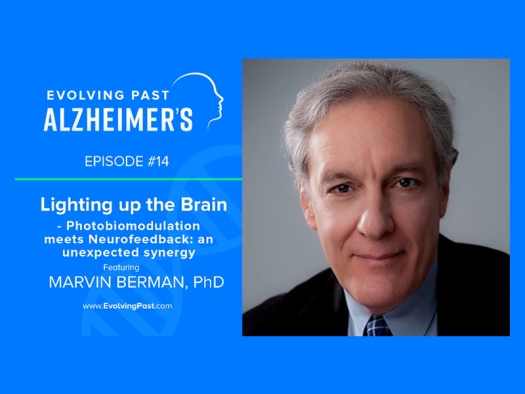LightingUpTheBrainPodcast.jpg

Evolving Past Alzheimer's
In Alzheimer's disease the brain shrinks over time. Certain forms of light energy may help defeat this problem. Near infrared wavelengths are particularly good because not only do they travel deeper into tissues; they are not lost by being absorbed by blood and water before they reach the brain.
In episode 14 of the Evolving Past Alzheimer's podcast, host Dr. Nate Bergman talks with Dr. Marvin Berman about two different and distinct technologies: Photobiomodulation and Neurofeedback.
Photobiomodulation (PBM) introduces certain frequencies of light. The light has an impact on the brain's mitochondria. Institutions like Harvard, Standford and MIT all have and continue to explore Photobiomodulation.
Lighting up the Brain - Photobiomodulation meets Neurofeedback: an unexpected synergy with Dr...
Evolving Past Alzheimer's
LED lights are placed around the head and shined into the nose and they seem to do several beneficial things. The signaling within the brain tissue takes place as a result of exposure to light (photonic) energy.
The key players in the PBM story are:
- Cytochrome C oxidase (substance that absorbs light)
- ATP (energy and healing)
- Reactive Oxygen Species – mild oxidant that signals cellular repair
- Nitric Oxide (increases blood flow)
Mitochondria have a substance called the cytochrome oxidase that can absorb red and near infrared light and convert the energy into a form of biological energy called ATP. Part of what ATP does is lead to healing and tissue repair. The process – among other things – generates a mild level oxidant (ROS) which acts as a signaling molecule to activate transcription factors that lead to tissue repair. Some people see this as a "redox" signaling molecule. Herein is where the physical healing can be accelerated when photonic therapies (red and near infrared light) is introduces.
Another important player is Nitric oxide (NO) – if it sits in the cell it "clogs" the respiratory chain that leads to ATP production. PBM frees the NO back into the body and restores the function of the respiratory chain. Then it takes on an important wide ranging role of improving nerve function and improving circulation by relaxing the blood vessel walls.
Dr. Berman explains how he connected Neurofeedback and PBM in the development of a comprehensive treatment model. He explains the use of light frequency of 1060-1080nm.



